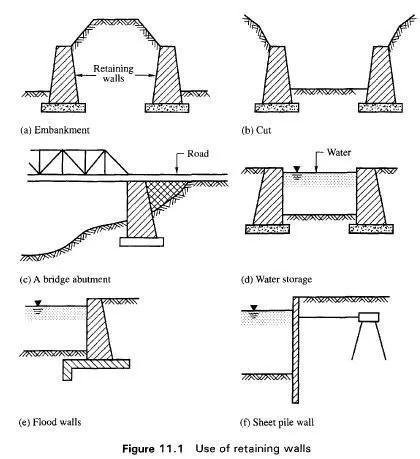Structures that are built to retain vertical or nearly vertical earth banks or any other material are called retaining walls. Retaining walls may be constructed of masonry or sheet piles. Some of the purposes for which retaining walls are used are shown in Fig. 11.1.
Retaining walls may retain water also. The earth retained may be natural soil or fill. The principal types of retaining walls are given in Figs. 11.1 and 11.2.
Whatever may be the type of wall, all the walls listed above have to withstand lateral pressures either from earth or any other material on their faces. The pressures acting on the walls try to move the walls from their position. The walls should be so designed as to keep them stable in their position. Gravity walls resist movement because of their heavy sections. They are built of mass concrete or stone or brick masonry. No reinforcement is required in these walls. Semi-gravity walls are not as heavy as gravity walls. A small amount of reinforcement is used for reducing the mass of concrete. The stems of cantilever walls are thinner in section. The base slab is the cantilever portion. These walls are made of reinforced concrete. Counterfort walls are similar to cantilever walls except that the stem of the walls span horizontally between vertical brackets known as counterforts. The counterforts are provided on the backfill side. Buttressed walls are similar to counterfort walls except the brackets or buttress walls are provided on the opposite side of the backfill.
In all these cases, the backfill tries to move the wall from its position. The movement of the wall is partly resisted by the wall itself and partly by soil in front of the wall.
Sheet pile walls are more flexible than the other types. The earth pressure on these walls is dealt with in Chapter 20. There is another type of wall that is gaining popularity. This is mechanically stabilized reinforced earth retaining walls (MSE) which will be dealt with later on. This chapter deals with lateral earth pressures only.
